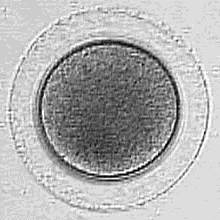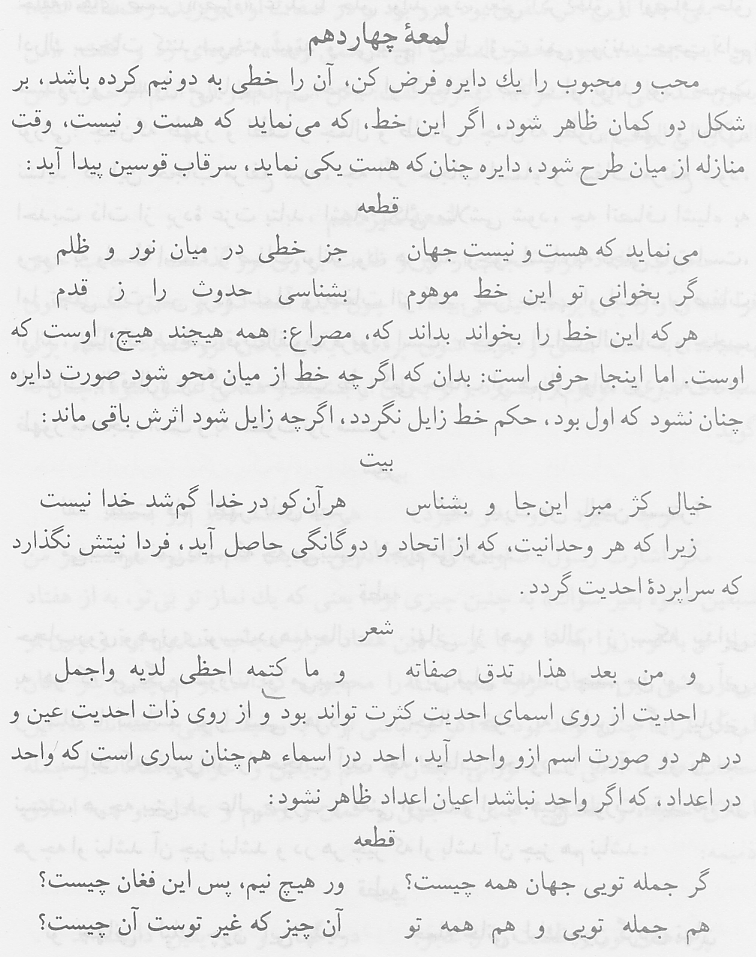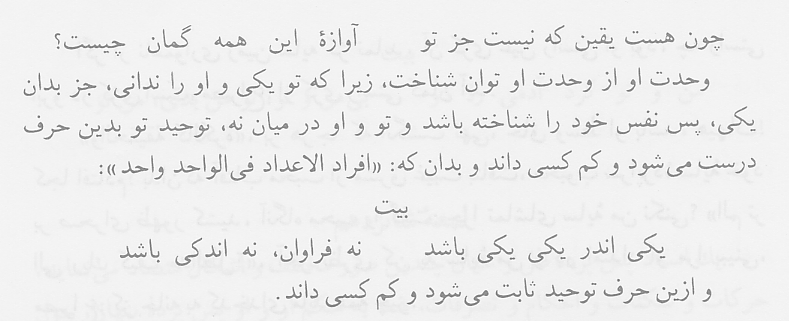
Lesson 14
Imagine the lover and beloved
being a circle, a line going
through halving it and making the shape of two arcs to appear. If this
line,
which differentiates one from the other (i.e. lover apart from
beloved), during the
strife (between being-lover and not-being beloved) forced out, so the
circle as
is (cut in half) remaining a whole, the secret of ”distance of but two
bow-lengths” [1] uncovered:
Renders
the existence and non-existence of the universe
Nothing
except a line between the light and the darkness
If you can
read this mysterious ambiguous line [2]
Distinguishing
an ancient continuum from anew phenomenon
Those who can read this line
know for sure: “Everything is
nothing nil, It is indeed only It Self”. But there is something here
left to be
said, know that although the line has vanished however the circle is
not as it
was at first, the effect of line is not banished, although the line
itself
banished its impact survived:
Think not
astray here and come to know
Whomsoever
is lost in Lord is not the Lord [3]
Because reuniting, which is
obtained from the unity of two
objects, Its singular uniqueness will not allow One-ness:
And after
this, is most subtle about Its attributes [4]
And the
more allots, the more conceals, the more manifolds
One-ness due to Its Names
(knowledge(s), attributes,
descriptions…) is copious, but in terms of Its essence (Zaat) is unique
and
pure [5]. In either case the derived Names
from It are unique and
unmistaken-ably singular. Within the Names the One-ness is similar to
‘1’ in
numbers, and if (‘1’) it does not serve as a unit the essence of
numbers shall
not be manifested
[6]:
If all
things are You, then what is this world for?
If I am
nothing, then what are all these screams for?
All things
are You and You are everything
That which
is other than You, what is it for?
Since
absolutely assured nothing exists but You
What is
the legend of all these doubts for?
Its One-ness can only be
understood through Its One-ness
[7]. You (the reader) is only one (of
you) [8] though you understand nothing
about It except that It is only One. Be cognizant of your self that you
and It
are not in the same mix, Tawhid (One-ness of God) is thus derived and
few
comprehend, “Within the (infinite) numbers there is only one member
‘1’”:
‘1’ within
anything, only one there is
Not
numerous, not little, (only one) there is
[1] Araqi is using two Arabic/Koranic
words exactly as used
in Koran[53:9]:
Which describes the account of
Angel Gabriel’s proximity to
Prophet Mohammad in their early meetings. Now Araqi uses this as an
abstract
form of art to play with words as a poet. I can not see any
relationship with
this verse of Koran and this lesson.
This opened new horizons for
me, “Koran is beautiful, use it
to adorn (sometimes) rather than scriptural justification”.
[2] Arabic words ‘Hodooth’ and ‘Qedam’
were used which
translated into ‘something new’ and ‘something old’. In the context of
this
poem and lesson I translated them into ‘new phenomenon’ and ‘ancient
continuum’. Not very happy with this usage…
[3] Araqi used earlier the example of
line through the
circle, which separates the two: The lover and the beloved. Although
they both
are one circle, however this line clearly separates the two halves in
most
meaningful fashion. Then he says, if you re-unite with your Lord does
not mean
you become one with It. Be not silly! Like thinking that half arch is
the
entire circle.
[4] The more the Creator hides It Self
and makes Its
attributes (Sifat) subtly manifest. Example, we are strong because of
the
Creator’s attribute strength, which was bestowed upon us to continue
our life
on this planet. When we move our muscles with strength the Creator is
completely hidden, we see It not! Though in most subtle manner we are
using Its
attribute strength. Its other attributes e.g. mercy, knowledgeable,
pure... are
subtly put into a attribute-manifold which carefully conceals us from
It Self.
[5] ‘One-ness’ of the Creator can be
described, exemplified,
formulated, theorized, depicted, rendered, simulated, imagined… in
infinite
many different forms and fashions of intellect, however it is still
talking
about the uniqueness of Allah.
[6] If there is no number ‘1’ then
there is no basis for any
other numbers (infinite many of them) to be derived from. Similarly,
there is
One Creator, but from this One-ness is derived infinitely many
creations.
[7] All attributes of Beloved can only
be understood through
the Beloved It Self. Knowledge can only be obtained and understood
through It Self as
The Most Knowledgeable
(Al-Alim). Mercy can
only be understood through It Self as the
Most Merciful (Ar-Rahim). Thus Araqi makes a profound discovery that
the
One-ness of the Creator can only be comprehended through It’s own
unique-ness
and singularity. Not through anything from us or the nature around us.
It is
because It wants us to understand Its One-ness that we sense the unique
higher
power in the universe and within us. Else we would have not sensate
anything.
[8] There is one of me i.e. finite and
how can I
understand this beyond comprehension infinite Super Being?
©
2003-2002,
Dara Shayda






